|
 |
| Dudley Street
Dudley Street has long been Wolverhampton’s main shopping
street, possibly because of its close proximity to the old
market that was held in High Green, now called Queen Square.
High Green included Lich
Gates, and the northern end of Dudley Street, which from its
junction with King Street and Woolpack Alley to Queen Square,
was known as High Green, and then High Street, until the
early twentieth century.
Wolverhampton had a market as early as
1179. In 1204 King John took great exception to the
existence of the market without a royal charter, and on 4th
February, 1258, King Henry III granted a charter for a
market and fair, to the Lord of the Manor, Giles de
Erdington, Dean of Wolverhampton. There would be a weekly
market on Wednesdays, and an eight day annual fair that was
held on the vigil of the feast of St. Peter and St. Paul. A
market Hall was built on the eastern side of high Green in
1532, on the site of the old medieval market cross.
In medieval times the northern part of
Dudley Street (previously High Street) was in the manor of
the Prebend of Hatherton, and included a horse mill, close
to the corner of Woolpack Alley.
Much of Wolverhampton was owned by the
Leveson family who made a fortune from the wool trade. In
1609, a detailed survey of Sir Walter Leveson’s
Wolverhampton estates, provides us with a comprehensive list
of his tenants, his property, and his land. At this time the
Swan Inn stood on the site of Lloyds Bank, and a little
further down near the junction of King Street was a large
house, rented by Elizabeth Pershouse, which had a big garden
at the back. Nearby were large houses, also with big gardens
that were rented by John Wightwick, John Key, and Richard
Shenton. Another large house, which stood roughly where
Marks & Spencer's shop is today, belonged to Thomas
Molineux. Leveson’s tenants on the western side of the
street included Henry Smythe, and also Richard Brett and
Hugh Sambrooke, who lived in cottages that were opposite the
main entrance to the Old Hall, the Leveson’s home. |
|
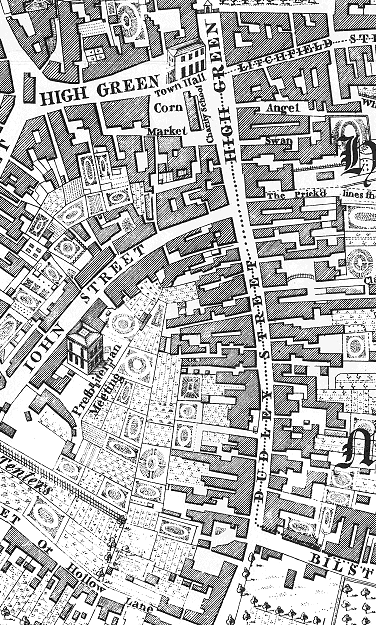
Part of Isaac Taylor’s map of 1750. |
Isaac Taylor’s map of 1750, clearly
shows the large gardens that were behind some of the grand
houses in the street, and also the Charity School that stood
at the north western end of the street, along with the old
market hall that stood in High Green.
The Charity School was built in about
1710 for the education of the town's poor people. In 1716
the school master was paid £26 per year, the school mistress
received £12 per year, and the school governess received
£7-10s-0d per year.
The school and market hall were
purchased by the Town Commissioners in 1779 under the
provisions of the first Improvement Act of 1777, and soon
demolished.
The grand houses were eventually
replaced by shops and businesses, possibly because of the
nearby market, and passing trade. Dudley Street was one of
the main routes to the south. In 1770 Pearson & Evans were
producing coffee mills in the street, and a few years later
Thomas Gibbons and John Marshall opened Wolverhampton's
first bank there.
Two coaching Inns, the Angel and the
Swan stood at the northern end of the street, looking into
High Green. The Swan, which stood on the site now occupied
by Lloyds Bank, had a large yard at the back where
Wolverhampton’s first theatre was built in the 1770s. It was
about 80ft. long and 36ft. wide, and could seat around 600
people. |
|
The 1802 Wolverhampton Rate Book gives
us an insight into the varied businesses that were based in
Dudley Street in April 1801, when the book was compiled.
They included: |
|
Name |
Profession |
Street number |
|
Name |
Profession |
Street number |
| Thomas Robbins |
butcher |
1 |
|
Edward Jennings |
victualler |
29 |
| Richard Ryley |
shopkeeper |
2 |
|
John Grosvenor |
factor |
30 |
| William Spilsbury |
victualler |
3 |
|
Robert Reeves |
locksmith |
33 |
| Thomas Adams |
breeches maker |
5 |
|
Thomas Gibbon |
factor |
36 |
| Charles Sitchell |
currier |
6 |
|
William Chreese |
lawyer |
37 |
| Philip Deakin |
druggist & grocer |
7 |
|
John Fox |
victualler |
38 |
| William Forester |
liquor merchant |
9/10 |
|
Messrs. Chreese |
lawyers |
41 |
| John Richards |
brazier |
11 |
|
? Endor |
wool comber |
43 |
| William Clark |
locksmith |
12 |
|
John Peace |
victualler |
44/45 |
| Joseph Taylor |
shopkeeper |
14 |
|
William Morris |
musical instrument
maker |
46 |
| Mary Clarke |
rawhide maker |
15 |
|
Elizabeth Barney |
victualler |
47/48 |
| John Davenhill |
grocer |
16 |
|
Dorothy Tooth |
grocer |
49 |
| Peter Highfield |
wig maker |
17 |
|
Thomas Evans |
dealer in textiles |
50 |
| Mary Culwick |
rawhide maker |
21 |
|
Andrew Mitchell |
victualler |
51 |
| Henry Wood |
candle maker & grocer |
22 |
|
William Tompson |
grocer |
52 |
| Sarah Pauton |
bailiff |
23 |
|
William Tompson |
watchmaker |
55 |
| Thomas Povey |
butcher |
24 |
|
Joseph Timmins |
shoe maker |
56 |
| John Smith |
grocer |
25 |
|
James Winne |
cooper |
57/58 |
| James Edwards |
breeches maker |
26 |
|
John Kaye |
candle maker & grocer |
59 |
| William Gibbons |
victualler |
27 |
|
Thomas Bateman |
wig maker |
60 |
|
| A look at Pigot & Company's 1828 Directory of
Staffordshire reveals the diversity of businesses in the
street at the time. There were four bakers, three boot and
shoe makers, three butchers, two cheesemongers, a brazier, a
bookseller and stationer, a fishmonger and fruiterer, seven
grocers, an ironmonger, a jeweller and silversmith, two
drapers, an Irish linen importer, two milliners, a saddler,
two straw hat makers, five tailors, two candle makers, six
public houses, and a wine and spirit merchant.
Coaches ran to many destinations from the coaching inns,
including the Swan, the Angel Inn, the Peacock, and the
Crown and Cushion.
Carriers ran to many local towns from the Pack Horse Inn,
the Angel Inn, and the Old King's Head. |

Dudley Street, as seen from High Green
in 1835. From a painting by Robert Noyes. |
In 1835, an omnibus service began operating from the
Fountain Inn in New Street, Birmingham to the Pack Horse Inn
in Dudley Street, run by Mr. John Doughty. In September of
the following year, the Midlands Omnibus Company opened an
office in Dudley Street,
from where services ran to High Street in Birmingham. By
1838 the company ran four direct journeys daily, and two via
Walsall, from the Crown & Cushion, in Dudley Street. By 1847 the number of journeys from the Crown
& Cushion to Birmingham had increased to seven daily, the
journey taking 95 minutes. The coach went via Bilston, and
West Bromwich. Another coach ran twice daily from the pub to
Walsall via Willenhall, and yet another coach ran on the
same route from the Red Cow, in Dudley Street, three times
daily.
Another service to Birmingham also started in 1836, run by
the Birmingham Omnibus Conveyance Company. Two journeys were
made daily from the Castle Inn in Dudley Street. By 1838 omnibuses were also running to
Ironbridge, Shifnal, Wednesbury, and Willenhall.
|
| The following is a list of the businesses in
Dudley Street and High Street, taken from the 1851
edition of William White’s ‘History, Gazetteer, and
Directory of Staffordshire’. |
|
Bakers & Flour Dealers |
James Bradshaw & Sons, Edward Burton,
and George Jenson |
|
Bookseller & Stationer |
Alfred Jolly Caldicott |
|
Boot & shoemakers |
William Carlow, and Joseph Finlow |
|
Butchers |
Richard Boulton, James
Ford, Thomas Gilpin, Susannah Newey, and
Thomas Skitt & Company |
|
Cheesemonger |
George Hill and Sons |
|
Chemists &
Druggists |
Joseph Ford, Alexander Gow,
William Hobbins, Frederick Langman, and
William Lowe |
|
Clothes Shop |
John Langman |
|
Coffee & Malt Mill
Maker |
George Jenson |
|
Confectioners |
George Jenson, Samuel Meek,
and John Owen |
|
Corn Miller &
Dealer |
James Bradshaw & Sons of
the Albion Mill |
|
Currier & Leather
Cutter |
William Carlow |
|
Draper |
Frederick Andrews |
|
Gardener & Seedsman |
James Bradshaw & Sons |
|
Gas Fitter |
Henry Banks |
|
Grocers & Tea
Dealers |
Henry Anslow, James
Bradshaw & Sons, George Dodson & Company,
George Hand, George Hardwick, George Hill &
Sons, Frank Jackson, and
William Henry Weaver |
|
Haberdasher |
John Parry |
|
Hatters |
D. L. Davis & Company,
George Devereux, and George Hardwick |
|
Hinge Maker |
W. W. Andrews |
|
Horse & Gig Hirers |
Thomas Brookes, and John
Icke |
|
Hop Merchant |
James Bradshaw & Sons |
|
Hosiers & Lace
Sellers |
Isaac Bingham, Mrs. Bunch,
William Cooley, Thomas Edwards, Gittos and
Beddows, George Lancaster, John Parry, and
John & Joseph Wheeler |
|
Inns & Taverns |
The Lord Russell, the Old
Kings Head, and the Red Cow |
|
Insurance Agent |
Thomas Shaw |
|
Iron & Steel
Merchant |
Joseph Underhill |
|
Iron Brazier |
Joseph Charles |
|
Ironmongers |
William Ward Andrew, Henry
Banks, and Joseph Charles |
|
Linen & Woollen
Drapers |
Thomas R. & Frederick
Andrews, Isaac Bingham, Gittos & Beddows,
Thomas Edwards, Thomas Shaw, Shoolbred &
Company, Christopher Smith,
John Underhill, and John & Joseph Wheeler |
|
Lock Maker |
Joseph Duce & Son |
|
Merchant & Factor |
Joseph Underhill& Son |
|
Pawnbroker |
James Langman |
|
Saddlers |
John Barnett, and Henry
Glaze |
|
Tailors |
Thomas Lloyd Shaw, and John
Langman & Son |
|
Wine & Spirit
Merchants |
George Hardwick, John
Harris, Alexander Patterson, and Alfred
Peters |
|
|
| Dudley Street featured in the celebrations in 1866 when
Queen Victoria unveiled the statue in Queen Square. There
were many gas-lit illuminations including an eight feet high
star and V.R. on the front of G. and W. Underhill's
ironmongers shop, a large illuminated shield above Masters,
wine and spirit merchants shop, a succession of stars above
James Tolefree's linen drapers shop, and a large crown
across the front of Henry Banks' ironmongers, and Frank
Walker's drapers shop, at numbers 10 and 11. |
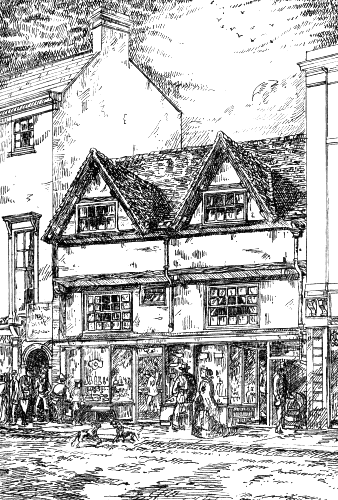 |
|
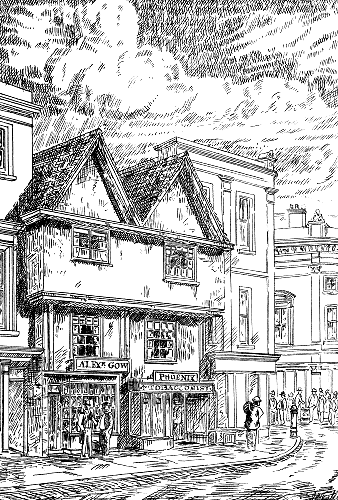 |
| Two drawings
by J. R. Veal, from his book Old Houses in
Wolverhampton and the Neighbourhood, published in
1889. The image on the right shows Alexander Gow's
chemist shop at 5 Dudley Street (then High Street),
and Phoenix tobacconists next door, with King Street
on the right. |
|
|

The shops above, on the left. Courtesy
of Eardley Lewis. |
 |
Another view of the shops.
Also from the Eardley Lewis
collection. |
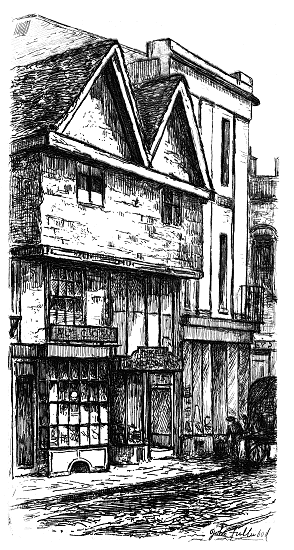 |
|
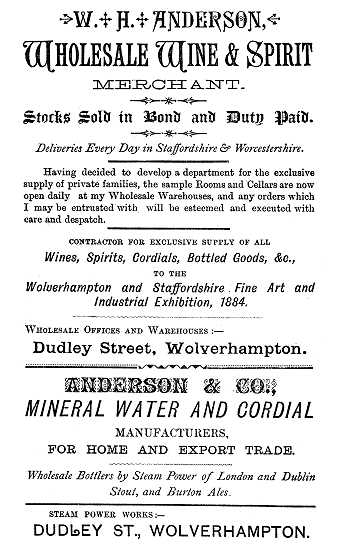 |
| John
Fullwood's version of J. R. Veal's drawing that's
above on the right. |
|
An advert
from 1884. |
|
|

A photograph of the shops above.
Courtesy of Eardley Lewis. |
|
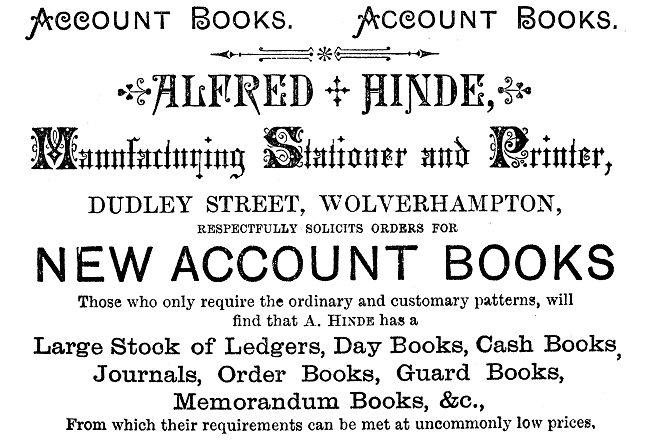
An advert from 1884. |
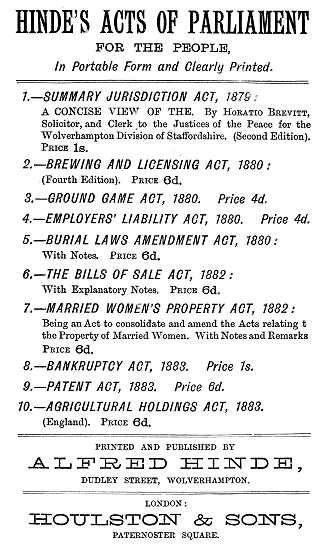 |
|
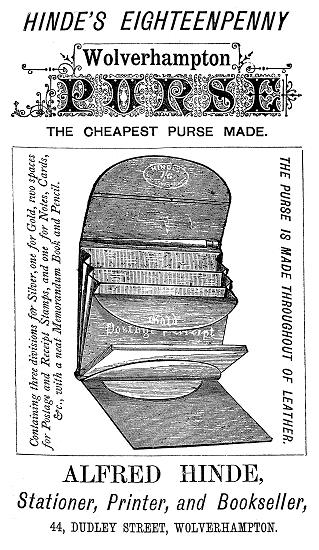 |
|
Two adverts
from 1884. |
|
 |
|
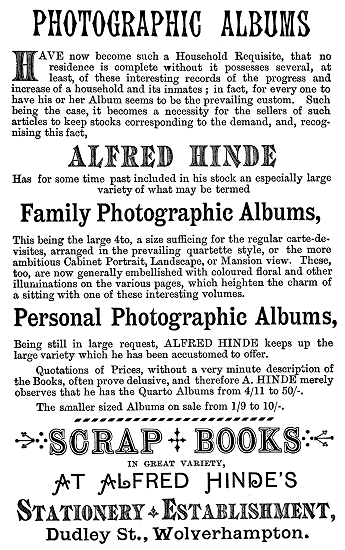 |
|
Two adverts from 1884. |
|
|
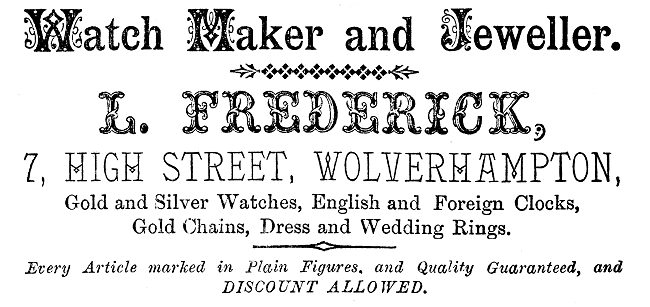
An advert from 1884. |
|
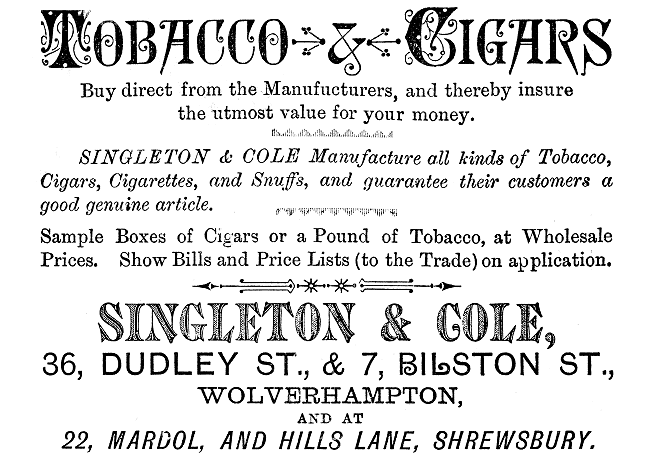
An advert from 1884. |
|
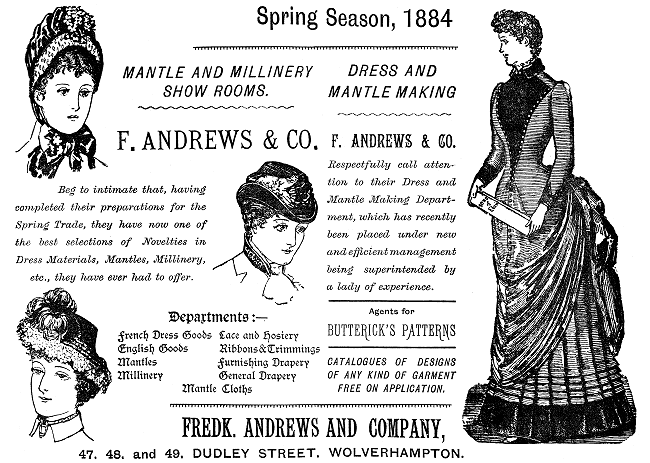
An advert from 1884. |
 |
A cold wintry day in the late
nineteenth century. From the
Eardley Lewis collection. |
 |
|
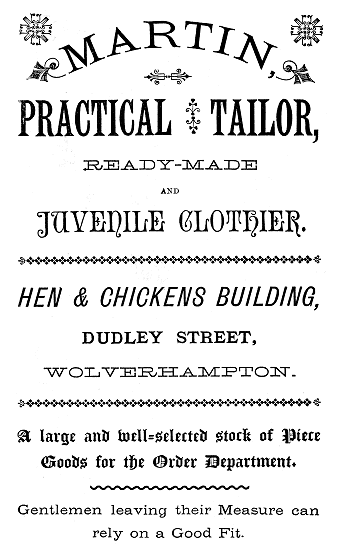 |
|
Two adverts
from 1884. |
|
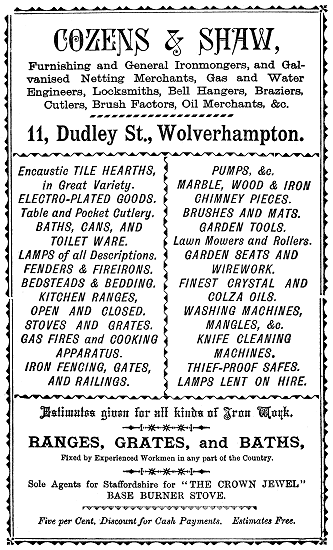 |
|
 |
|
Two adverts
from 1884. |
|
|
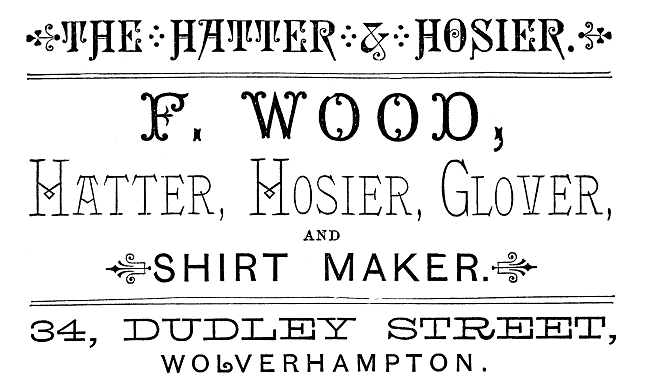
An advert from 1884. |
|
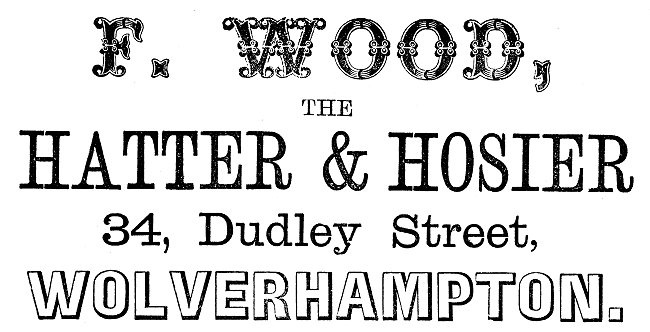
An advert from 1884. |
|

Dudley Street in about 1900. By Alan
Eaton. |
|
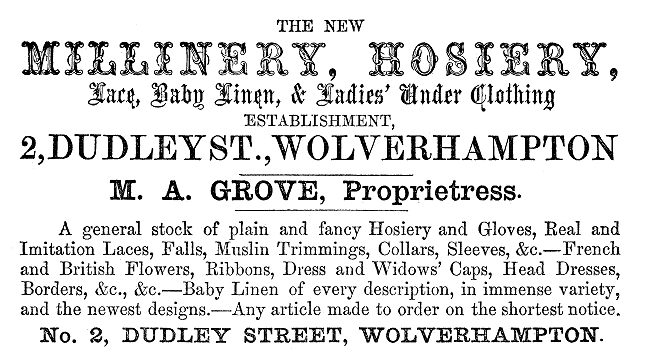
An advert from 1861. |
|
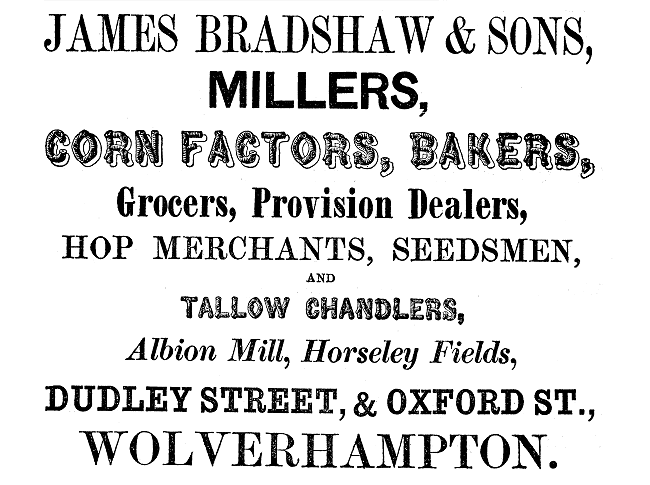
An advert from 1861. |
|
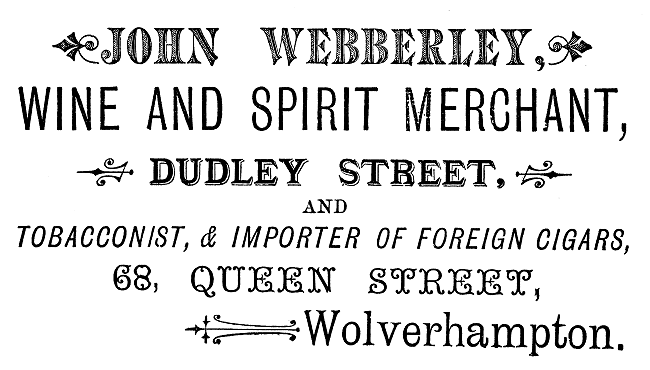
An advert from 1884. |
|

An advert from 1884. |
|

An advert from 1884. |
 |
A view from the 1920s.
From the Eardley Lewis Collection. |
| Another view from the 1920s.
Also from the Eardley Lewis
Collection. |
 |
 |
|
 |
|
Return to
contents |
|
Proceed to mid
19th century shops |
|